Wildflowers of the Adirondacks:
Pickerelweed (Pontederia cordata)
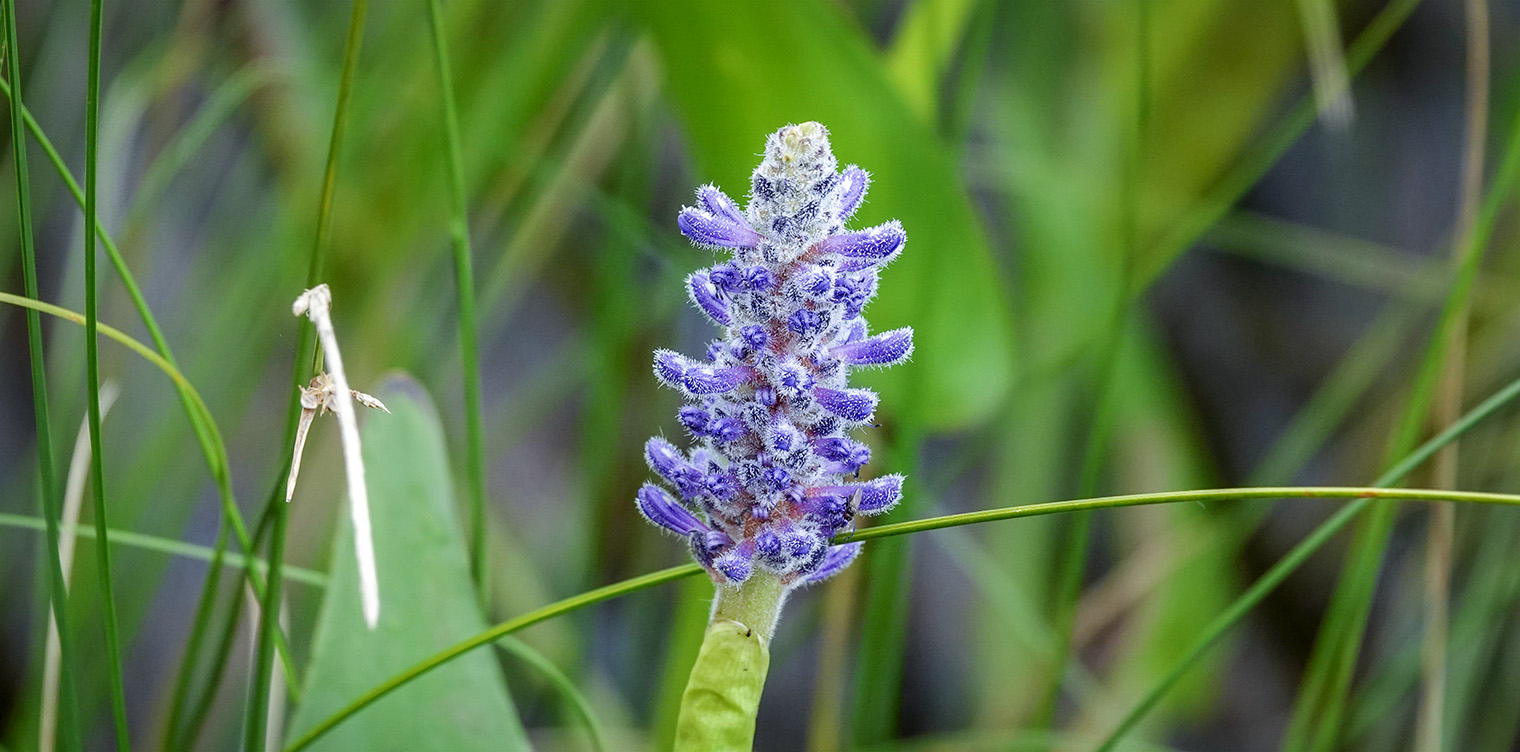
Pickerelweed (Pontederia cordata) is an aquatic plant with purple flowers seen in the shallow edges of ponds, streams, and marshes in the Adirondacks.
- The common name (Pickerelweed) is an apparent reference to the pickerel fish. While there is no evidence that the plant has any special association with pickerel, it does provide shade and shelter to aquatic organisms.
- The genus name (Pontederia) is a reference to Guilio Pontedera, an 18th century professor of botany at Padua.
- The species name (cordata) is a reference to the plant's heart-shaped leaves.
Identification of Pickerelweed
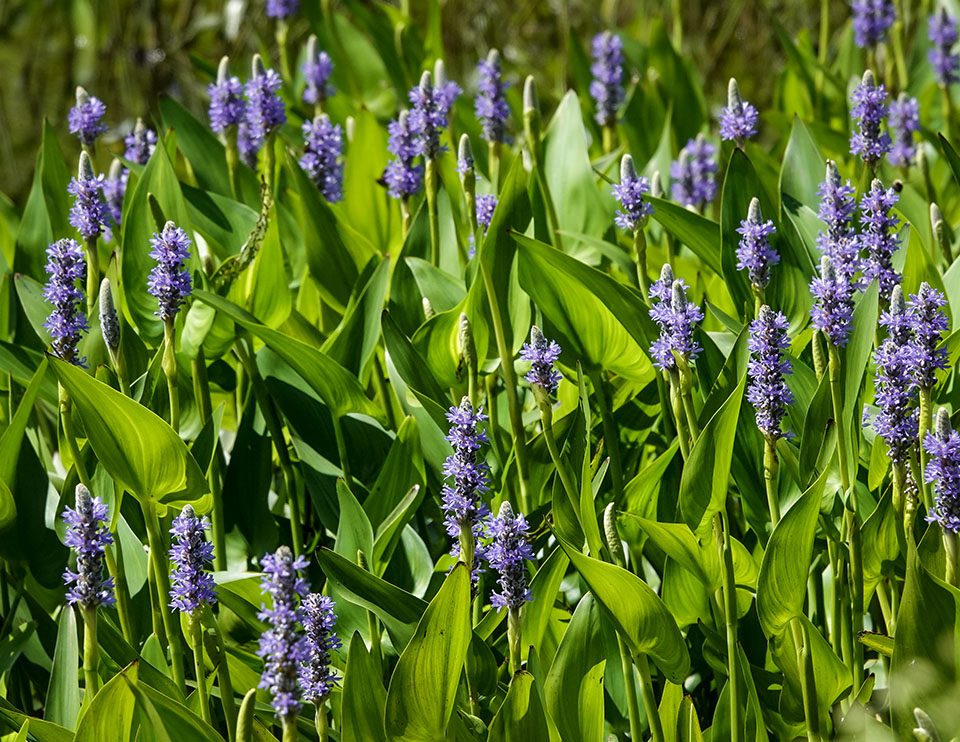
Pickerelweed is a perennial emergent that can reach three to four feet in height. Emergents are plants that are rooted on the bottom with stems and leaves rising above the surface of the water. In the case of Pickerelweed, the stems and leaves emerge annually from a thick pad of fibrous roots. The plant spreads by colony-forming rhizomes Rhizome: The modified subterranean stem of a plant that sends out roots and shoots from its nodes. Rhizomes are also called creeping rootstalks and rootstocks.. Pickerelweed seldom grows in water above three feet in depth.
Rhizome: The modified subterranean stem of a plant that sends out roots and shoots from its nodes. Rhizomes are also called creeping rootstalks and rootstocks.. Pickerelweed seldom grows in water above three feet in depth.
Pickerelweed's deep green, waxy leaves emerge at the end of the stems. They are quite variable in shape and size. They are arrowhead or heart-shaped, ranging in size from 2 to 10 inches in length and 1 to 6 inches in width.
Pickerelweed produces showy purple-blue flowers on a spike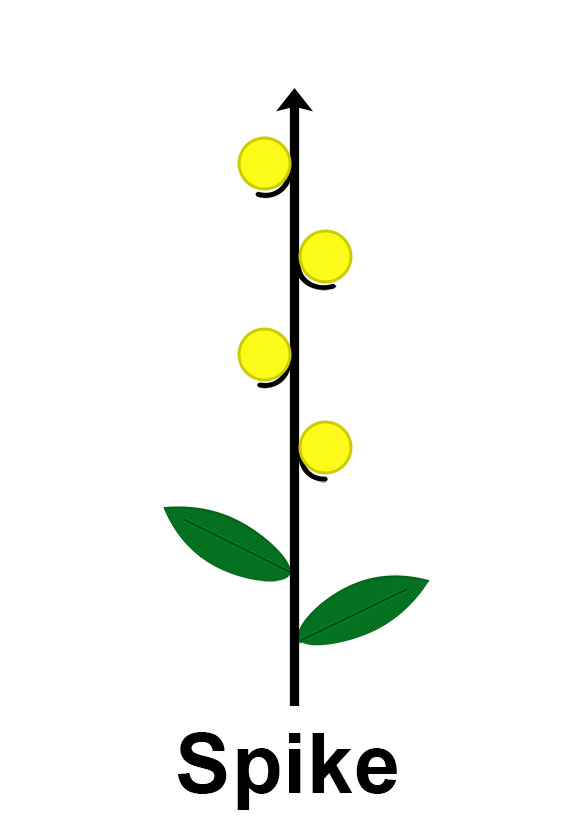 Spike: An unbranched stalk of flowers. Each flower or flowerhead is attached directly to the central stalk. up to six inches long. Each individual flower is about 1/3 inch long. Each flower has shallow lobes on the upper lip and deeper lobes on the lower lip. The upper central lobe is marked with yellow. The flowers bloom in succession from the bottom up. Each flower lasts only about a day.
Spike: An unbranched stalk of flowers. Each flower or flowerhead is attached directly to the central stalk. up to six inches long. Each individual flower is about 1/3 inch long. Each flower has shallow lobes on the upper lip and deeper lobes on the lower lip. The upper central lobe is marked with yellow. The flowers bloom in succession from the bottom up. Each flower lasts only about a day.
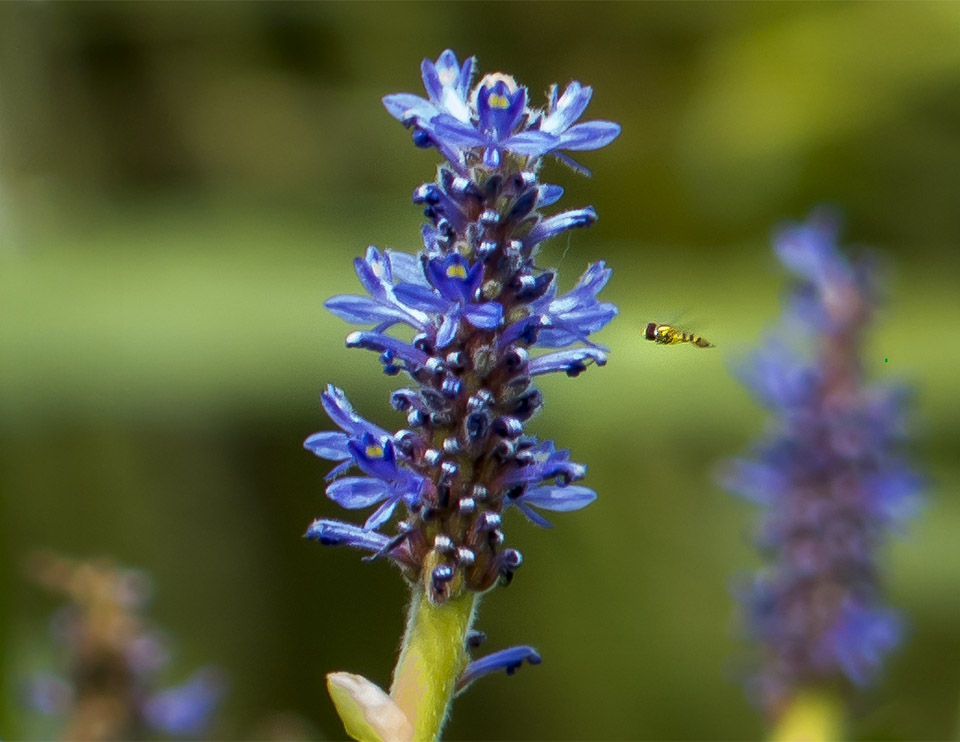
In the Adirondack Park, Pickerelweed is usually in bloom from late June through August and early September.
- A tally of flowering dates for the upland Adirondack areas compiled by Michael Kudish, based on data collected from the early seventies to the early nineties, lists 16 July as the earliest date of flowering, 8 August as the median date, and 16 September as the latest date.
- In recent years, Pickerelweed has been starting to bloom somewhat earlier. In some years, this species has been seen blooming in late June and early July. The bloom times reflected on the last two years of Adirondack Park iNaturalist observations suggest that the normal pattern of flowering times for Pickerelweed is from mid-July to early September.
The fruit of Pickerelweed is a small, ridged, dry seed. It is tightly clustered along a spike, and changes from green to tan or light brown.
Uses of Pickerelweed
Pickerelweed has minimal human uses. It reportedly has been used for food. Both the leaves and the seeds are said to be edible. Some sources claim that the seeds, which reportedly have a nutty flavor, can be eaten like nuts straight from the plant or dried and added to cereal. The young leaves have sometimes been eaten raw in salads, cooked like spinach, or added to soups. Some native American tribes have used the plant as a contraceptive.
Wildlife Value of Pickerelweed
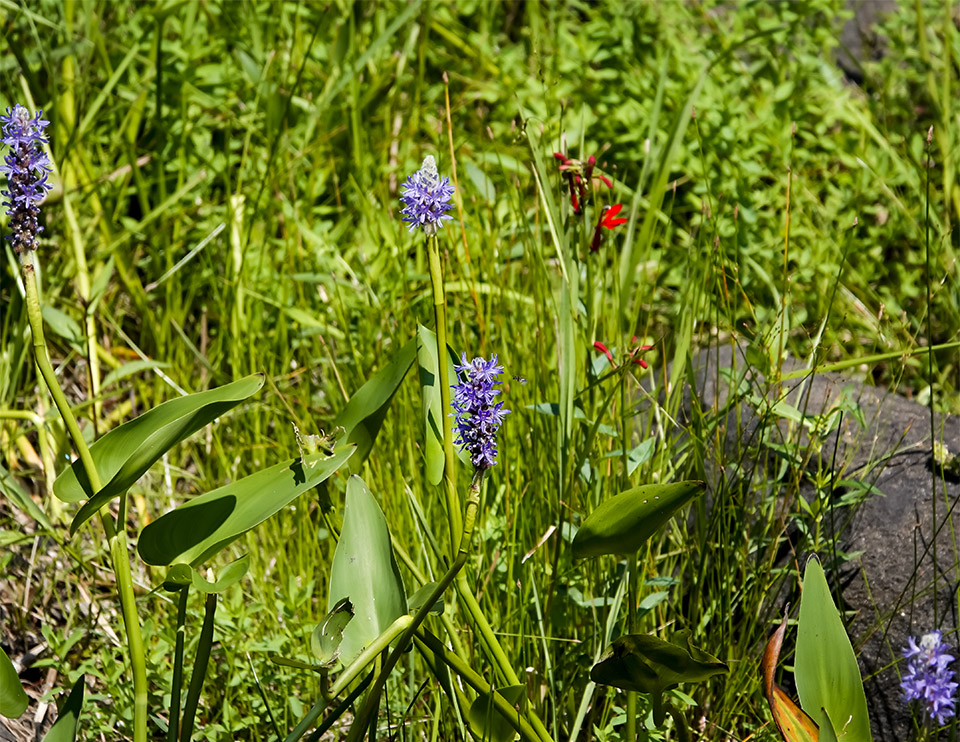
Pickerelweed is of some value to wildlife. The seed is eaten by waterfowl, including Wood Ducks, Mallards, and American Black Ducks. Canada Geese, White-tailed Deer, and Muskrats consume the vegetation. However, in all cases, this plant constitutes less than 2% of their diet. Fish, and to a lesser extent birds and small mammals, utilize the foliage for cover. In terms of general value to wildlife, Pickerelweed is lower in value than many other emergents that grow near it.
Bees are Pickerelweed's primary pollinators. Ruby-throated Hummingbirds are also occasional pollinators. Pickerelweed also provides birth sites for dragonflies and damselflies.
Distribution of Pickerelweed
Pickerelweed grows in eastern North America, from Nova Scotia to Minnesota, south to Florida and Texas. It is listed as threatened in Kentucky.
Pickerelweed is found in most counties in New York State. Vouchered plant specimens have been recorded for all counties within the Adirondack Park Blue Line, with the exceptions of Clinton and Hamilton counties.
Habitat of Pickerelweed
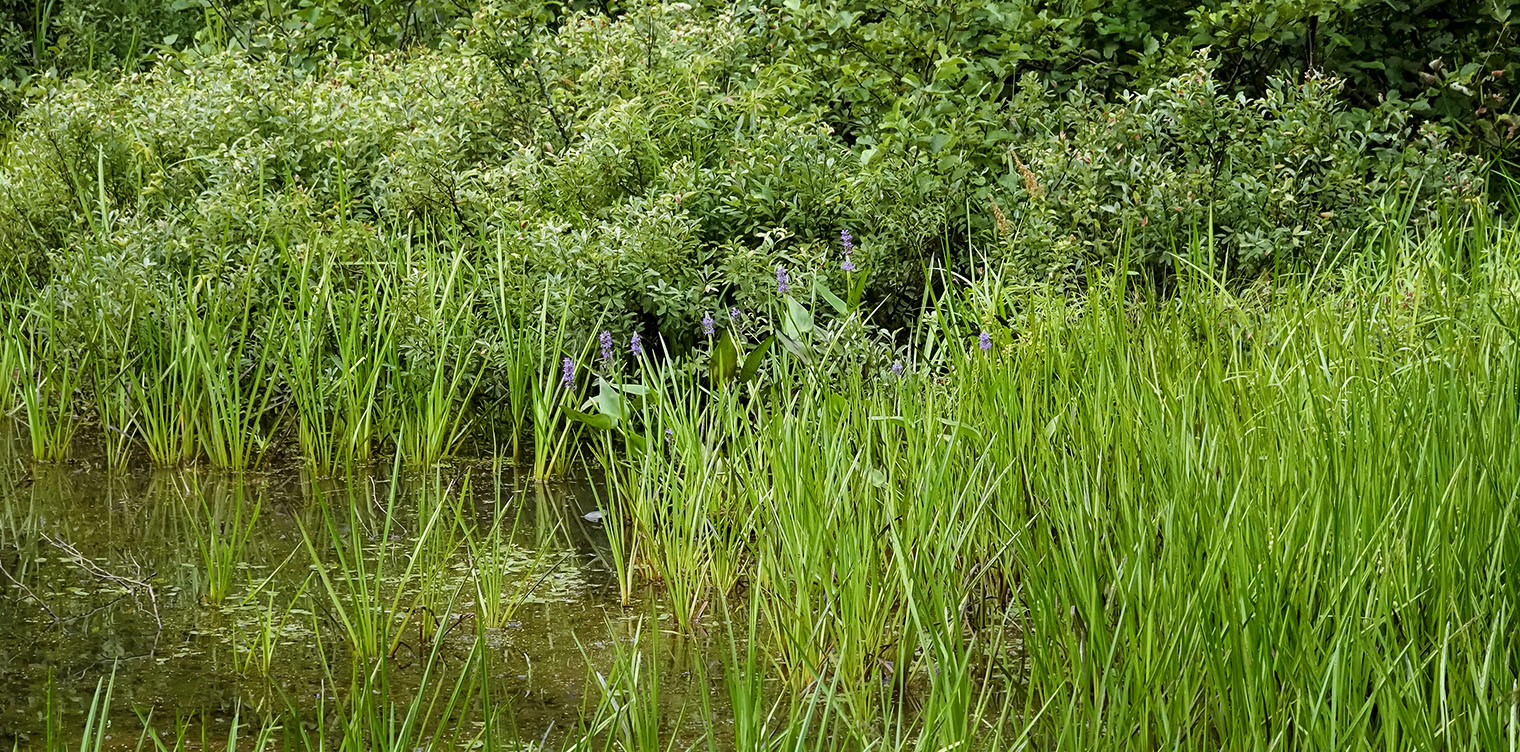
Pickerelweed is typically found in quiet, shallow water, such as marshes and the marshy edges of lakes, ponds, and slow-moving streams. Its plant associates include cattails and water lilies. In the Adirondack Mountains, Pickerelweed is found in several wetland ecological communities, including:
Pickerelweed can be seen along many trails that skirt wetland areas.
- Pickerelweed blooms in profusion on Heron Marsh at the Paul Smith's College VIC and may be seen from the Heron Marsh Trail, Barnum Brook Trail, and Woods & Waters Trail. It can also be seen along the Barnum Bog boardwalk on the Boreal Life Trail, growing on the edges of Barnum Brook. Pickerelweed can also be found in the wetland areas along the Black Pond Trail.
- You can also find Pickerelweed growing on the marshy edges of the small pond at John Brown Farm.
- Look for Pickerelweed in the wetland areas along the Sucker Brook Trail at the Adirondack Interpretive Center.
References
Michael Kudish. Adirondack Upland Flora: An Ecological Perspective (The Chauncy Press, 1992), pp. 27, 228.
New York Flora Association. New York Flora Atlas. Pickerelweed. Pontederia cordata L. Retrieved 10 May 2017.
United States Department of Agriculture. The Plants Database. Pickerelweed. Pontederia cordata L. Retrieved 10 May 2017.
United States Department of Agriculture. NRCS National Plant Data Center & the Biota of North America Program. Plant Guide. Pickerelweed. Pontederia cordata L. Retrieved 10 May 2017.
Flora of North America. Pontederia cordata Linnaeus. Retrieved 10 May 2017.
NatureServe Explorer. Online Encyclopedia of Life. Pickerelweed. Pontederia cordata - L. Retrieved 10 May 2017.
Native Plant Trust. Go Botany. Pontederia cordata L. Pickerelweed. Retrieved 24 February 2020.
New York State. Department of Environmental Conservation. New York Natural Heritage Program. Ecological Communities of New York State. Second Edition (March 2014), pp. 47-48. Retrieved 17 October 2015.
New York Natural Heritage Program. 2021. Online Conservation Guide for Backwater Slough. Retrieved 21 July 2021.
New York Natural Heritage Program. 2021. Online Conservation Guide for Deep Emergent Marsh. Retrieved 21 July 2021.
New York Natural Heritage Program. 2021. Online Conservation Guide for Inland Calcareous Lake Shore. Retrieved 21 July 2021.
New York State. Adirondack Park Agency. Preliminary List of Species Native Within the Adirondack Park Listed Alphabetically by Scientific Name and Sorted by Habit. Volume 1. Updated 10.23.2006, p. 61. Retrieved 26 January 2017.
Connecticut Botanical Society. Pickerelweed. Pontederia cordata L. Retrieved 10 May 2017.
University of Wisconsin. Flora of Wisconsin. Pontederia cordata L. Retrieved 10 May 2017.
Minnesota Wildflowers. Pontederia cordata (Pickerelweed). Retrieved 10 May 2017.
Illinois Wildflowers. Pickerelweed. Pontederia cordata. Retrieved 15 May 2017.
Lady Bird Johnson Wildflower Center. Pontederia cordata. Retrieved 10 May 2017.
iNaturalist. Adirondack Park Observations. Pickerelweed. Pontederia cordata. Retrieved 21 July 2021.
Plants for a Future. Pontederia cordata - L. Retrieved 24 February 2020.
University of Michigan. Native American Ethnobotany. A Database of Foods, Drugs, Dyes and Fibers of Native American Peoples, Derived from Plants. Pontederia cordata L. Retrieved 13 May 2017.
Meiyin Wu & Dennis Kalma. Wetland Plants of the Adirondacks: Herbaceous Plants and Aquatic Plants (Trafford Publishing, 2011), pp. 108.
Anne McGrath. Wildflowers of the Adirondacks (EarthWords, 2000), p. 92.
Doug Ladd. North Woods Wildflowers (Falcon Publishing, 2001), p. 58.
Lawrence Newcomb. Newcomb's Wildflower Guide (Little Brown and Company, 1977), pp. 50-51.
Roger Tory Peterson and Margaret McKenny. A Field Guide to Wildflowers. Northeastern and North-central North America (Houghton Mifflin Company, 1968) pp. 316-317.
National Audubon Society. Field Guide to Wildflowers. Eastern Region. (Alfred A. Knopf, 2001), pp. 706-707.
William K. Chapman, et al. Wildflowers of New York in Color (Syracuse University Press, 1998), pp. 126-127.
Donald D. Cox, A Naturalist's Guide to Wetland Plants. An Ecology for Eastern North America (Syracuse University Press, 2002), pp. 62, 69, 171.
Alexander C. Martin, Herbert S. Zim, and Arnold L. Nelson. American Wildlife & Plants. A Guide to Wildlife Food Habits (Dover Publications, 1951), p. 448.
John Eastman. The Book of Swamp and Bog: Trees, Shrubs, and Wildflowers of Eastern Freshwater Wetlands (Stackpole Books, 1995), pp. 141-143.
Tom Seymour. Foraging New England: Edible Wild Food and Medicinal Plants from Maine to the Adirondacks to Long Island Sound. Second Edition (Morris Book Publishing, LLC, 2013), pp. 117-118.
Allen J. Coombes. Dictionary of Plant Names (Timber Press, 1994), p. 148.
Wildflowers of the Adirondack Park
